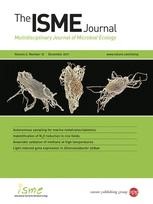-
Views
-
Cite
Cite
Thomas Holler, Friedrich Widdel, Katrin Knittel, Rudolf Amann, Matthias Y Kellermann, Kai-Uwe Hinrichs, Andreas Teske, Antje Boetius, Gunter Wegener, Thermophilic anaerobic oxidation of methane by marine microbial consortia, The ISME Journal, Volume 5, Issue 12, December 2011, Pages 1946–1956, https://doi.org/10.1038/ismej.2011.77
Close - Share Icon Share
Abstract
The anaerobic oxidation of methane (AOM) with sulfate controls the emission of the greenhouse gas methane from the ocean floor. AOM is performed by microbial consortia of archaea (ANME) associated with partners related to sulfate-reducing bacteria. In vitro enrichments of AOM were so far only successful at temperatures ⩽25 °C; however, energy gain for growth by AOM with sulfate is in principle also possible at higher temperatures. Sequences of 16S rRNA genes and core lipids characteristic for ANME as well as hints of in situ AOM activity were indeed reported for geothermally heated marine environments, yet no direct evidence for thermophilic growth of marine ANME consortia was obtained to date. To study possible thermophilic AOM, we investigated hydrothermally influenced sediment from the Guaymas Basin. In vitro incubations showed activity of sulfate-dependent methane oxidation between 5 and 70 °C with an apparent optimum between 45 and 60 °C. AOM was absent at temperatures ⩾75 °C. Long-term enrichment of AOM was fastest at 50 °C, yielding a 13-fold increase of methane-dependent sulfate reduction within 250 days, equivalent to an apparent doubling time of 68 days. The enrichments were dominated by novel ANME-1 consortia, mostly associated with bacterial partners of the deltaproteobacterial HotSeep-1 cluster, a deeply branching phylogenetic group previously found in a butane-amended 60 °C-enrichment culture of Guaymas sediments. The closest relatives (Desulfurella spp.; Hippea maritima) are moderately thermophilic sulfur reducers. Results indicate that AOM and ANME archaea could be of biogeochemical relevance not only in cold to moderate but also in hot marine habitats.




